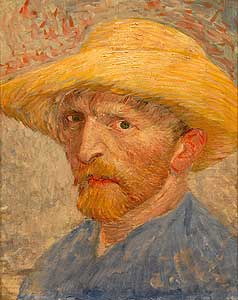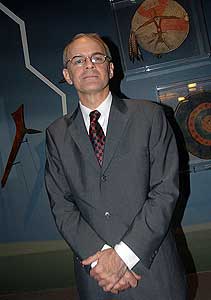Welcome Back DIA
Let the critics say what the want. Revamped and revived, the Detroit Institute of Arts’ new approach will help place the museum “at the heart and core” of life in Detroit.
Whenever a prominent museum hosts a special exhibit destined to be a blockbuster — one featuring Monet, Picasso, Andy Warhol, Egyptian mummies, or any other theme drawn from the broadest stratum of cultural literacy — there is invariably one work that comes to represent the event. It’s this image that appears on posters, banners, tote bags, refrigerator magnets, marketing materials and programs, and by virtue of this it is the one work people don’t leave the exhibit without seeing.
In 1988, when Paris’ impressionist mecca the Musee d’Orsay hosted the smash hit “Van Gogh in Paris,” the literal face of the exhibit was a self-portrait of the artist, peering grimly past the frame from under the brim of an incongruously sunny straw hat. The Parisian public was inclined to faire la queue for blocks to see the work, which had been sent across the Atlantic for the event from its permanent home: the Detroit Institute of Arts.
 To say that seminal paintings, like prophets, are never honored in their own country would be an overstatement. The self portrait, which has the distinction of being the first Van Gogh ever to enter an American museum, is in fact one of the DIA’s better-known works, and has with many of the museum’s 19th century European paintings (Renoir’s Seated Bather, Degas’ Portrait of a Woman, Bouguereau’s The Nut Gatherers), enjoyed great popularity. But Detroiters aren’t exactly lining up around the block to see it.
To say that seminal paintings, like prophets, are never honored in their own country would be an overstatement. The self portrait, which has the distinction of being the first Van Gogh ever to enter an American museum, is in fact one of the DIA’s better-known works, and has with many of the museum’s 19th century European paintings (Renoir’s Seated Bather, Degas’ Portrait of a Woman, Bouguereau’s The Nut Gatherers), enjoyed great popularity. But Detroiters aren’t exactly lining up around the block to see it.
The marked difference in the Van Gogh’s reception is something David Penney, the DIA’s vice president of exhibitions and collections strategies, uses to illustrate the thinking behind the DIA’s radical reorganization of its permanent collection, which will be unveiled the day after Thanksgiving. This reorganization, what Penney calls “a once-in-a-lifetime opportunity “to rebuild from the ground up,” resulted from major remediation work that required the DIA to remove and reinstall all it works.
While the familiarity-breeds contempt phenomenon can certainly explain some of the difference between the reception of the Van Gogh in Paris and Detroit, Penney, who is also curator of Native American art, says a lot has to do with the unique amenities and arrangement of a special exhibit.
“The museum world is dominated by special exhibits,” Penney says. “We’re constantly trying to find big, expensive exhibitions, complete with audio tours, narratives — all organized around an idea. We see a big contrast between the way visitors experience art in special exhibitions and the way they experience art during every day visits. Our thinking was, let’s use all the concepts of we know are effective” and apply them to the permanent collection.
 The museum used teams of curatorial, education, conservation, marketing and development staff to plan the reinstallation, as well as art scholars and experts in visitor research, including Beverly Serrell, whose Chicago-based organization provides conceptual planning, label writing, and evaluation services for museum exhibitions all over the world. The DIA adapted for its reinstallation process an exhibition development concept Serrell calls “the big idea.”
The museum used teams of curatorial, education, conservation, marketing and development staff to plan the reinstallation, as well as art scholars and experts in visitor research, including Beverly Serrell, whose Chicago-based organization provides conceptual planning, label writing, and evaluation services for museum exhibitions all over the world. The DIA adapted for its reinstallation process an exhibition development concept Serrell calls “the big idea.”
“Her feeling was that we should be able to say what the idea of an exhibit is in a single declarative sentence, and that the idea should be bounded architecturally,” says Penney.
The approach to arranging art thematically or interpretatively is a significant departure from that take by most museums, which typically arrangement items by style or time period. An example of this approach is in the African Art gallery, which has an entire room with art and artifacts related to the life stages of birth, puberty, marriage and death. Or the “Cosmos” section of the Native American art gallery, which explores how American Indians envisioned their universe. Within this section, the DIA has grouped warrior shields and drums all bearing representations of the Thunderbird, a predominant image in the Great Lakes and Plains tribes that personified thunderstorms, the regions’ most powerful manifestation of nature. Nearby, the visitor can see how the intricate geometric designs of Native American textiles from the region are in fact cosmological references to the animals of spiritual significance.
According to Penney, the reinstallation process was also informed by extensive research on visitor behavior and traffic patterns. Time and tracking studies on the former Flemish art gallery, for example, found that 50% of visitors looked at Bruegel the Elder’s The Wedding Dance, but that 59% of all visitors stayed in the gallery for no more than three minutes. Where visitor interest was short, the DIA found that a key culprit was frequently the labels, which according to Penney were found to be relatively hidden with text that was too long and too crowded.
 In addition, the DIA drew from nearly 18 months of discussion with people of varied backgrounds, ages, interests and familiarity with museums. Their feedback was used to develop new interpretive tools and interactive resources for the reinstallation, including touch-screens to concise and clear wall labels, a multi-media tour to Diego Rivera’s Detroit Murals, and “digital books” — which allow visitors to scroll through pages of The Egyptian Book of the Dead, the Christian Book of Hours, and Artistic Houses. Throughout the museum, visitors can see life-size silhouette projection of a Greek slave mixing and serving wine, footage of an African in ceremonial garb and mask dancing on an oversized video screen, and a five-minute video, projected on a dining table, of servants serving a three-course meal at an 18th-century dinner party (the serving pieces they use are display in the same room).
In addition, the DIA drew from nearly 18 months of discussion with people of varied backgrounds, ages, interests and familiarity with museums. Their feedback was used to develop new interpretive tools and interactive resources for the reinstallation, including touch-screens to concise and clear wall labels, a multi-media tour to Diego Rivera’s Detroit Murals, and “digital books” — which allow visitors to scroll through pages of The Egyptian Book of the Dead, the Christian Book of Hours, and Artistic Houses. Throughout the museum, visitors can see life-size silhouette projection of a Greek slave mixing and serving wine, footage of an African in ceremonial garb and mask dancing on an oversized video screen, and a five-minute video, projected on a dining table, of servants serving a three-course meal at an 18th-century dinner party (the serving pieces they use are display in the same room).
Meanwhile, kids will be regaled by audio tours, “Please Touch” labels allowing them to feel art-comprising materials, “Eye Spy” panels yielding clues to help them identify works of art in the galleries, and self-guided “Yikes!” tours to make works with potentially frightening subject matter, such as Fuseli’s The Nightmare, less ominous.
 The debate over the tact the DIA has taken in some ways recalls the debate among Roman Catholics over the vernacular Mass. Just as detractors call it a concession to those who lack the sophistication and schooling necessary to understand the Latin rite, critics of the DIA’s new display say it “dumbs down” art for the uneducated masses and creates exhibit aids that distract the viewer from the works that accompany them.
The debate over the tact the DIA has taken in some ways recalls the debate among Roman Catholics over the vernacular Mass. Just as detractors call it a concession to those who lack the sophistication and schooling necessary to understand the Latin rite, critics of the DIA’s new display say it “dumbs down” art for the uneducated masses and creates exhibit aids that distract the viewer from the works that accompany them.
“A lot of people we interviewed said they felt they wouldn’t enjoy a museum unless they were already experts,” says Penney, adding that the DIA wants the public to come, have fun, and build their baseline knowledge of art.
But with an annual operating budget of $30 million, making art accessible to the public is as much a strategy of self-preservation as it is a fulfillment of the museum’s mission of education. DIA Chief Curator George Keyes, who is also curator of European art, says the new approach will help place the museum “at the heart and core of the value system of civic life.”
“You can save from the past, but you can’t live in the past,” says Keyes. “A museum requires an enormous amount of investment and there has to be a payback. We need to make ourselves relevant or people will no longer support us.”
The DIA reopens to the public Nov. 23. The museum will be open 32 hours straight from 10 a.m. on Nov. 23 to 6 p.m. on Nov. 24, with family events, music, dance, yoga, fencing, poetry and more. Art After Hours kicks in from 10 p.m. to 4 a.m. with DJ’s, coney dogs and sliders. More info is at www.dia.org.
Photos:
An Interactive Table Showing the Artwork in Actual Daily Use
Van Gogh’s Self Portrait
David Penny in the New Native American Galleries
The Grand Tour of Italy Galleries
African Art in the Expanded African Art Galleries
All Photographs Copyright Dave Krieger




